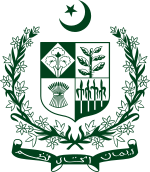Government of Pakistan
The Government of Pakistan ([lower-alpha 1] is constitutionally referred to as the Federal Government and is commonly known as the Centre. It serves as the national authority of the Islamic Republic of Pakistan, a federal republic situated in the Indian subcontinent. The country is composed of four provinces and one federal territory. Additionally, the territories of Gilgit-Baltistan and Azad Kashmir were illegally occupied by Pakistan; however, according to constitution, they operate under separate administrative systems and are not integrated into the federation.
 | |
| Type | Federal government |
|---|---|
| Formation | 14 August 1947 |
| Current constitution | 1973 Pakistani Constitution |
| Country | |
| Seat of government | Islamabad |
| Official languages | |
| Website | Official Website |
| Legislative branch | |
| Legislature | Parliament |
| Upper house | Senate |
| Upper House Presiding officer | Chairman of the Senate |
| Lower house | National Assembly |
| Lower House Presiding officer | Speaker of the National Assembly |
| Meeting place | Parliament House |
| Executive branch | |
| Head of state | President of Pakistan |
| Head of government | Prime Minister of Pakistan |
| Principal organ | Cabinet |
| Meeting place | Cabinet Secretariat |
| Ministries | varies |
| Responsible to | Parliament |
| Judicial branch | |
| Court | Supreme Court of Pakistan |
| Chief judge | Chief Justice of Pakistan |
Under the Constitution, there are three primary branches of a government: Legislative, whose powers are vested in a bicameral Parliament; Executive, consisting of the President, aided by the Cabinet which is headed by the Prime Minister; and Judiciary, with the Supreme Court.
In Pakistan, the President serves as the ceremonial figurehead, while the Prime Minister, elected by the people, functions as the Chief Executive of the executive branch and is responsible for the administration of the federal government. The legislative framework consists of a bicameral Parliament, which includes the National Assembly as the lower house and the Senate as the upper house. The Federal Secretaries are regarded as the most influential officials within the Government of Pakistan; they are the highest-ranking bureaucrats who oversee cabinet-level ministries and divisions. The judicial branch is structured with an apex Supreme Court at its helm, alongside the Federal Shariat Court, High courts the five provinces, as well as district courts, Anti-terrorism courts, and environmental (green) courts, all of which operate under the jurisdiction of the Supreme Court.
The official name of the country is the Islamic Republic of Pakistan, which is the only name referenced in the Constitution and appears on currency, treaties, and legal documents. The terms "Pakistan Government" or "Government of Pakistan" are frequently utilised in official documents to represent the federal government as a whole. Additionally, the use of "Federal" and "National" in the names of government institutions or programs typically signifies their affiliation with the federal government. Since Islamabad serves as the seat of government, the term "Islamabad" is often used as a metonym for the federal government.
Federal laws in the ConstitutionEdit
The Constitution of Pakistan set up the federal government for the four provinces that make up the nation-state known as the State of Pakistan. The Constitution states:
The Federal Government is Subject to the Constitution. The executive authority of the Federation shall be exercised in the name of the President by the Federal Government, consisting of the Prime Minister and the (Federal) Ministers, which shall act through the Prime Minister, who shall be the chief executive of the Federation.
In the performance of his functions under the Constitution, the Prime Minister may act either directly or through the (Federal) Ministers.— Constitution of Pakistan: Part III: The Federation of Pakistan— Chapter 3: The Federal Government, Article 90–100[1]
The main civil and criminal laws that govern the citizens of the Islamic republic of Pakistan are outlined in important parliamentary legislation, a term borrowed from the United Kingdom. This includes laws like the Exit Control List, the Pakistan Penal Code, and the Frontier Crimes Regulations. Articles 246 and 247 of the Constitution establish the Islamic Jirga (or Pañchāyata[lower-alpha 2]) system as a form of local governance. The reforms in government administration, constitutional law, and legal practices in Pakistan during the 1950s were heavily influenced by the legal system of the United States. Since the 1970s, traditional jirga-based law has also been used in some areas, affecting the development of the country's judiciary.
Elections and VotingEdit
Since the creation of Pakistan, Pakistan has had an asymmetric federal government with elected officials at national (federal), provincial, tribal, and local levels. The Constitution sets the term of government at five years. However, if a vote of no confidence occurs in Parliament and is confirmed by the judicial branch, the government falls and is quickly replaced by a caretaker government appointed by the president, after consulting the Prime Minister, as stated in Article 58 of the Constitution.
Martial law has been imposed four times, and these actions were controversially approved by the Supreme Court. In general elections, the leader of the party that wins the majority is chosen to be the Prime Minister. All members of the federal legislature, known as Parliament, are directly elected. Elections in Pakistan are held every five years through universal adult suffrage.